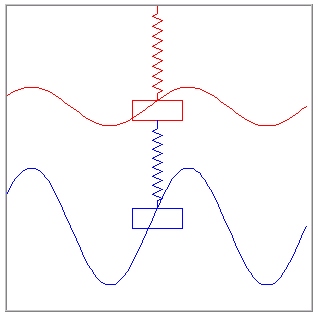This section describes a fictitious on-line course module for understanding an important application of "initial value problem" theory, namely, mechanical and electrical oscillations. This example puts into practice the techexplorer Document Object Model (DOM) Java API as well as leverages many of the connections between JavaScript, techexplorer, and HTML constructs.
In this section we will touch on the important aspects of the LaTeX and HTML source of the SpringMass module as well as describe the usage of the Document Object Model API in the SpringMass Applet. Once we are done, try out the SpringMass course module!
The LaTeX source of the course module uses a \docLink to start a new web browser
window containing the SpringMass Java applet. Here is the \docLink source:
\centerline{
\docLink{javascript:if ( open( 'Springs.html', 'target', 'width=325, height=325, resizable=0, status=0, menubar=0, scrollbars=0' ) ) ; }
{\includegraphics{Springs.jpg}}
}
The contents of the \docLink URL is
JavaScript code for loading the Springs.html page into a new window named
target. When the user clicks on the image of the SpringMass Java applet,

the JavaScript code is executed.
First, the window will automatically close when the techexplorer
page is unloaded. Second, a JavaScript function provides access to the
techexplorer Java instance. The
The
Notice that the
The
IBM techexplorer Hypermedia Browser is a trademark of the
IBM Corporation.
The SpringMass HTML Source
The HTML source of the SpringMass applet plays an important role by providing hooks to the
web browser object model. Here is the source:
<HTML>
<HEAD>
<TITLE>IBM techexplorer Hypermedia Browser - Spring Mass Example
</HEAD>
<script>
function begin()
{
var opendoc = window.opener.document;
if ( opendoc.TEPlugin )
document.applets["SpringMass"].setPlugin( opendoc.TEPlugin );
if ( opendoc.TEControl )
document.applets["SpringMass"].setControl( opendoc.TEControl );
}
window.opener.onunload = kill;
function kill()
{
window.close();
}
</script>
<BODY BGCOLOR="#FFFFFF" ONLOAD="begin()">
<TABLE BORDER=1 CELLSPACING=0 CELLPADDING=0>
<TR>
<TD>
<APPLET NAME="SpringMass"
ARCHIVE="NpSpringMass.jar"
CODE="SpringMass.class"
WIDTH=300 HEIGHT=300 MAYSCRIPT>
<PARAM NAME="cabbase" VALUE="AxSpringMass.cab">
</APPLET>
</TD>
</TR>
</TABLE>
</BODY>
</HTML>
SpringMass applet uses this
instance to change the initial conditions in the LaTeX document when a user changes the spring elongations.
The SpringMass Java Applet
SpringCanvas class houses the necessary
code for obtaining access to the Document Object Model hierarchy as well as code for
searching and updating the initial conditions. Here is the code for obtaining a reference
to the Document class:
public void getDocument()
{
document = (TEDocument) techexplorer.getDocumentNode();
}
getDocumentNode() method is used to obtain a
reference to the techexplorer Document node. When a blue or red "mass" is
dragged, the SpringMass applet uses the following method to update the initial conditions
in the document using objects and methods defined by the Document Object Model API.
public void mouseDragged(MouseEvent evt)
{
int y = evt.getY();
if (selectedBlock == 1) {
currentVals[0] = (y - slength - mheight/2)/20.0;
initVals[0] = currentVals[0];
/*
* Update the initial conditions via the Document Object Model
*/
Node centerLine = findFirstNodeFromName( (Node) document, "centerline" );
Node inlineMath = findFirstNodeFromName( (Node) centerLine.getNextSibling().getNextSibling(), "inline-math" );
NodeList nodeList = inlineMath.getChildNodes();
Text text = (Text) nodeList.item(2);
text.setData( formatInit(initVals[0]) );
nodeList = inlineMath.getNextSibling().getNextSibling().getChildNodes();
text = (Text) nodeList.item(2);
text.setData( formatInit(initVals[2]) );
document.recomposeAndRedraw();
repaint();
}
...
}
findFirstNodeFromName utility method uses the Document Object Model Node interface to
traverse the document tree recursively in search of the first node that has the given name.
private Node findFirstNodeFromName( Node node, String name )
{
Node inlineMathNode = null;
if ( node != null )
{
if ( node.getNodeType() == Node.TEXT_NODE )
if ( node.getNodeName().compareTo( name ) != 0 )
{
if ( node.hasChildNodes() )
{
NodeList nodeList = node.getChildNodes();
for( int i=0; i<nodeList.getLength(); i++ )
{
inlineMathNode = findFirstNodeFromName( nodeList.item( i ), name );
if ( inlineMathNode != null )
break;
}
}
else
if (debug) System.out.println( "findFirstNodeFromName: current node no children" );
}
else
inlineMathNode = node;
}
return inlineMathNode;
}
Send comments and questions to
techexpl@us.ibm.com.
Visit the official techexplorer home page at
http://www.software.ibm.com/techexplorer/.